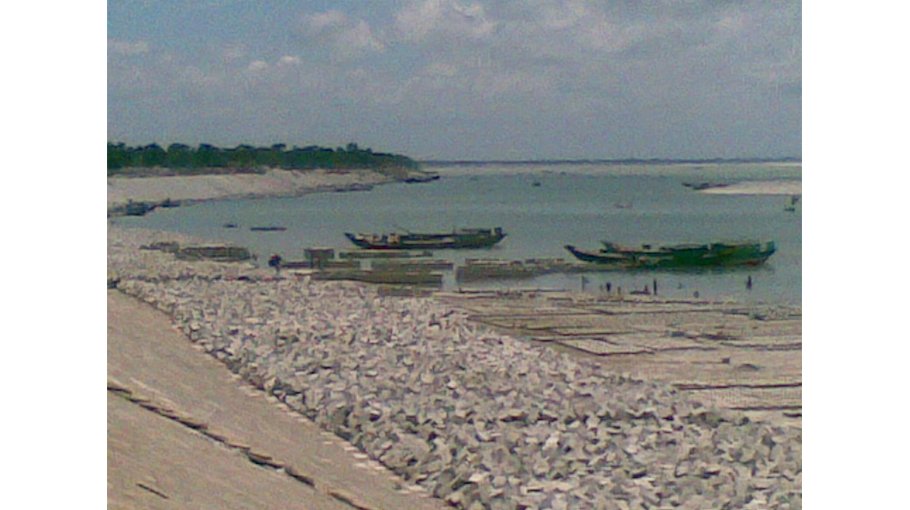Farakka Barrage affects 60m people in Bangladesh


At least 60 million (six crore) people in Bangladesh are directly affected by the adverse impact of the diversion of water from the river Ganges through the Farraka Barrage in India. Of these, about 20 million (two crore) people are affected in the northern region, mainly in the northern Barendra region. Another 40 million people in the southern and central regions of the country are facing an acute shortage of water due to the depletion of underground water levels caused by the impact of Farakka.
Dr. Mahbub Siddiqui, a river researcher and convener of the 49th Anniversary Celebration Committee of the historic Farakka Long March, presented this information to the journalists through a function in Rajshahi on Thursday on the historic Farakka Long March Day.
Dr. Mahbub Siddiqui further informed that irrigation activities were being disrupted in 65 percent of the areas under the Ganga- Kobadak (Kapotaksha) Project due to the Farakka barrage. 100 percent of deep tube wells in the Barendra region have become inoperative and 21 percent of shallow tube wells are almost ineffective. Hand pumps have lost their effectiveness in Barind region as the groundwater level has dropped.
At the same time, the presence of Arsenic in water has increased, making tubewell water in many districts of the northern and northwestern regions unfit for drinking.
Due to the decrease in water supply from upstream, salinity in the soil and water has increased alamingly in the southern part of the country. Rice production has decreased in Khulna and Satkhira regions. The biodiversity of the Sundarbans is also under threat. Due to the decrease in soil fertility, agriculture has been severely affected.
According to the report, in the last 40 years, the volume of the Padma River in the Rajshahi and Chapainawabganj regions has decreased by 50 percent. The depth of the river has decreased by 17.8 percent, and the water flow has decreased by 26.2 percent.
On January 1, 2023, the water flow in the Padma was 90,730 cusecs, while on January 1, 2024, it dropped to 75,409 cusecs. The water flow has decreased by 15,321 cusecs in a year. The average rainfall during this period was also 19.2 percent less.
Due to water shortage, the riverbed is gradually filling up. Some of the indigenous fishes and animals of the Padma, such as dolphins, gharials, and the arrival of Hilsa fish are now a thing of the past memory. Aquatic fauna were also being seriously endangered.
Giving the background of the Farakka problem, Dr. Mahbub Siddiqui mentioned that a five-year water sharing agreement was signed with India in 1977. In that agreement, it was mentioned that if the water quantity at Farakka point was 55,000 cusecs during the dry season, Bangladesh would get 34,500 cusecs.
If the water quantity decreased, Bangladesh would get at least 27,600 cusecs, which was a guarantee clause.
But in 1982, instead of renewing the agreement, a Memorandum of Understanding was signed. The guarantee clause was omitted, resulting in a severe violation of Bangladesh's rights.
According to Mahbub Siddiqui, India has been unilaterally withdrawing water through about 400 points upstream of the river Ganges. They are implementing three major canal projects using the diverted water of the river Ganges: The Projects are: Upper Ganges Canal Project, Madhya Ganges Canel Project and Lower Ganges Canal Project. In addition, the lower reaches of Bangladesh have been almost drained out of water for using the Ganges water in various States of India, from Haridwar to West Bengal.
Dr Mahbub Siddiqui highlighted several important recommendations to resolve the problem. These include: informing the public whether Bangladesh is actually receiving water as per the 1996 Bangladesh-India Ganges Water Sharing Agreement, forming a strong committee to conduct a full review of the agreement before the agreement expires in 2026, incorporating the 1977 guarantee clause in the new agreement, including Nepal in the Joint River Commission and holding regular meetings, forming an expert committee to analyse the impact of India's implementation of the inter-river linking project, forming a regional water forum (under the auspices of the United Nations and the World Bank), preparing to go to the International Court of Justice against India, and forming an expert team to assess compensation claims.
Dr. Mahbub Siddiqui called for viewing the Farakka problem not just as a water crisis, but as a socio-economic, environmental and geopolitical issue. According to him, “there is no alternative to strong national unity, active diplomacy and international cooperation to address this crisis.”
The function was organized by the 'Historic Farakka Long March 49th Anniversary Celebration Committee'. Senior politician Mahmud Jamal Quaderi, who participated in the Farakka Long March, and other concerned persons participated in the function.


